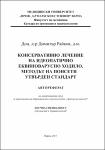Декларирам, че ще използвам предоставените материали от електронната библиотека съобразно чл.24, ал.1, т.9 от ЗАКОН ЗА АВТОРСКОТО ПРАВО И СРОДНИТЕ МУ ПРАВА единствено и само за научни, културни и образователни цели, без извличане на търговска полза, без търговски интерес и без цел печалба.Не Да

Conservative Treatment of Idiopathic Clubfoot. The Ponseti Method – Approved Standard // Консервативно лечение на вродено еквиноварусно ходило. Методът на Понсети-утвърден стандарт

Дата
2017Автор
Райков, Димитър
Raykov, Dimitar
dimitar.raikov@mu-varna.bg
Резюме
Лечението на еквиноварусното ходило е едно от големите предизвикателства в съвременната ортопедична наука и практика. Натрупаният опит в широко прилаганите в миналото различни оперативни процедури е съпровождан с огромни разочарования от ранните и късни рецидиви с лош за ходилото функционален край. Съвременното изучаване на структурните особености в съединителната тъкан на новороденото извеждат на преден план през последните десетилетия няколко консервативни метода в лечението, при които честотата на усложненията са значително редуцирани. Методът на Понсети се утвърди като принципно нов консервативен подход с в лечението на еквиноварусното ходило. Следвайки точно правилата в изпълнението му, успеваемостта в лечението достига до 92% с минимален риск от рецидиви. Настоящото проучване потвърждава високата успеваемост, но и изследва детайлно грешките, които се допускат от лекаря специалист, както и всички други обстоятелства, възникващи по време на лечението, които са причина за неуспехи – грешки или рецидиви. All orthopedists who have faced with the problems of clubfoot, in the past and nowadays, share the same opinion that achieving a success is a difficult task, regardless the management is conducted conservatively or surgically. The fact determined to be essential is that the early start leads to better results. Modern studies have established the role of the so-called “embryonic myosin” which later is substituted with normal myosin while the child is growing. This protein has proven extremely susceptible to manipulation and very sensitive to surgical influence. Thus, gradually and gentle casting in a specific sequence manages to achieve the correction of ligaments, joint capsules and tendons; the rearranged tarsal and metatarsal bones are remodeled. At the same time, upon surgical accesses by different methods this protein is quickly converted to rough scar tissue, which deteriorates the functions of the operated foot even short term after surgery. The objective of this paper is to provide results of the treatment of idiopathic clubfoot by Ponseti Method which convincingly demonstrate that if conducted correctly, the method ensures success. Patients. This study included 165 children (228 feet) with clubfoot within the period from 2001 to 2016. The criteria for inclusion were idiopathic type of deformity for which no previous surgical methods of treatment have been conducted till this point. All of them were treated using the protocol described by Ponseti. Results. Strictly adhering to Ponseti protocol, 29 feet (13%) were treated only by casting, and the other 199 (87%) were treated by casting and subsequent Achilles tenotomy. The average number of castings - 8 ; Recurrences of equinus and adduction - 34 (15%) feet; a second relapse in 21 (9%) feet,; unsuccessful results - 7 feet Discussion. The results obtained (97% successful correction within the follow-up period) correlate with those of other authors in the short-term. The reasons for recurrences occurred were analyzed as the preponderant role was the improper maintenance of the abduction device in the post-casting period. Conclusions. The high final result of 97% corrected feet makes the Ponseti method much more successful and preferred both by doctors who undertake to treat congenital clubfoot and by parents of children with such disease.
